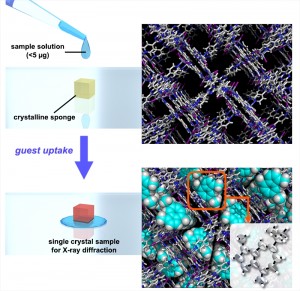Crystallography on the nanogram scale Crystalline sponges eliminate need for sample crystallization

Single Crystal X-ray analysis is a powerful tool for determining the structures of molecules and is widely used both in academic and industrial research. However, this analytical method has an intrinsic limitation that target samples have to be crystallized beforehand. As a result, most oily compounds or extremely small-quantity samples have not been analyzed by single crystal X-ray study solely because there was no way to crystallize them.

c Yasuhide Inokuma. Crystallographic analysis of a tiny quantity of sample using a crystalline sponge.
Prof. Makoto Fujita’s research group at the University of Tokyo’s Graduate School of Engineering solved this problem using a porous material called a “crystalline sponge”. Crystalline sponges are porous coordination network crystals capable of aligning incoming guest molecules inside their pores along an ordered framework of organic ligands and metal ions. Once the incoming guest molecules are regularly ordered, the resulting crystalline sponges meet the requirement for X-ray analysis, thus the structure of the guest molecule can be determined by X-ray crystallography without crystallizing the sample itself. The Fujita group demonstrated that molecular structures of non-crystalline samples were unambiguously determined by simply soaking a crystal of crystalline sponge in a solution containing from 80 ng up to 5 μg of the target sample.
With this new “crystalline sponge method,” the Fujita group successfully determined the crystal structures of medicinal compounds, natural flavonoids, and a very scarce marine natural product which is extracted from a marine sponge collected at a depth of 400 m.
This research provides an innovative tool to determine the structures of very tiny amounts of organic molecules in the field of medicinal drug, food, agrichemical, fragrance and fundamental organic research.
Paper
Yasuhide Inokuma, Shota Yoshioka, Junko Ariyoshi, Tatsuhiko Arai, Yuki Hitora, Kentaro Takada, Shigeki Matsunaga, Kari Rissanen, Makoto Fujita,
“Nano-to-microgram scale X-ray analysis using porous complexes”,
Nature 495, 461-466 (2013). Online Edition: 2013/3/28. doi: 10.1038/nature11990.
Article link
Links
Graduate School of Engineering
Department of Applied Chemistry, Graduate School of Engineering
Fujita laboratory, Department of Applied Chemistry, Graduate School of Engineering







